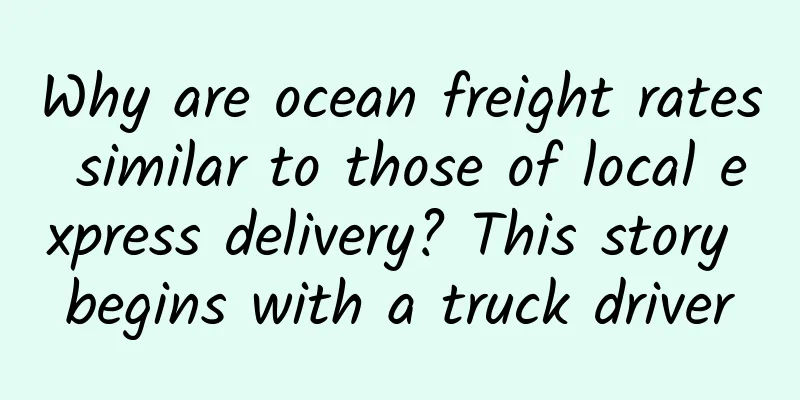Why are ocean freight rates similar to those of local express delivery? This story begins with a truck driver

|
"Imported goods are naturally more expensive, after all, they are shipped from such a faraway place." This statement is really wrong. The cost of ocean freight is actually similar to that of same-city express delivery. You may not imagine that a bottle of French red wine is loaded on a ship in Dunkirk, passes through the Strait of Gibraltar from the North Sea, passes through the Suez Canal through the Mediterranean Sea, enters the Indian Ocean from the Red Sea, and then enters the South my country Sea through the Strait of Malacca, and finally arrives in Shanghai. The actual freight cost of this voyage around half the world is less than 4 yuan. It's a lie, right? How can it be so cheap? It is so cheap, and it is precisely because of this that goods around the world can be circulated smoothly, and all this is thanks to a truck transport driver named "Malcolm McLean". Ocean freight was not so cheap from the beginning. In the past, the freight was actually frighteningly high. Why was the ocean freight so high in the past? There are two reasons. One is that the amount of goods transported in a single trip is limited. The other is that the entire transportation process lasts a long time, and most of the time is spent on loading and unloading. Ocean shipping in the past was very similar to express delivery today. Each seller packed each item individually and sent it to the express company. The express company would sort and load the goods after receiving them. After the goods arrived at the destination, they would be sorted again and distributed to different areas, and then delivered by different couriers. The same was true for ocean shipping in the past. People packed each piece of cargo separately, transported it on board and piled it in the cabin and on the deck. After arriving at the destination, the cargo was unpacked and shipped away one by one. This made the loading and unloading process extremely cumbersome and time-consuming. At that time, the time it took for an ocean-going cargo ship to load and unload cargo was longer than the time it took to cross the ocean. As the saying goes, time is money. With such a long delay, the freight naturally went up. This seemed to be an unsolvable problem at the time, until 1956, when a man named "Malcolm McLean" appeared. Malcolm McLean is a truck driver who often delivers goods to the port. After repeated observations, McLean raised a question: why can't the goods be packed in standardized boxes in advance, so that they can be quickly loaded onto the ship when the freighter arrives, and after arriving at the destination, the goods can be quickly unloaded at the dock, leaving it for the consignee to slowly unpack, and the freighter can immediately load again and return. According to McLean's suggestion, the first batch of 58 "McLean boxes" were officially shipped. The first trial voyage was from New Jersey to Houston. The result was amazing. After using the McLean boxes, the freight rate dropped significantly, from $6 per ton to 16 cents per ton. As a result of the success, containers, container ships and various supporting facilities have developed rapidly since then. After the emergence of modern standardized containers, ocean freight rates have once again dropped significantly. The size of a modern standardized container is 6 meters long, 2.4 meters wide and 2.55 meters high, and such a container is called 1TEU. The cargo ships that carry these containers are no longer ordinary cargo ships, but specially built container ships. The largest container ship in the world is HMM Algeciras, which is 400 meters long and has a container loading capacity of 24,000 TEUs. Wait a minute, container ships are big, but can they hold more than 20,000 containers? Although I haven't counted them myself, most people have seen container ships. Although there are many containers stacked on the deck, it is definitely impossible to reach more than 20,000. Yes, there are indeed not more than 20,000 containers that we can see at a glance, and there may not even be 10,000, but the key is that there are still more that we can't see. For ocean-going cargo ships, the more containers they load, the lower the freight rate, and in order to be able to load more cargo, container ships have no decks. Starting from the bottom of the ship, the container ship is divided by guide grooves into vertical shafts that match the size of the containers. Containers can be stacked from bottom to top in each shaft. After all the shafts are filled with containers, a hatch cover will be placed on top, and this hatch cover can be understood as the temporary deck of the container ship. Containers can continue to be stacked on the hatch cover, and the containers we can directly see are the containers stacked on the hatch cover. Of course, these containers are not simply stacked on the hatch cover, otherwise they will all fall into the sea in the event of strong winds and waves. In fact, the containers on the "temporary deck" are locked with twist locks, and each layer of containers stacked on top will be locked with twist locks on the containers below, and then they will be pulled to the deck with lashing rods. With so many safety protections, no matter how strong the wind and waves are, the containers will not fall into the sea. Thanks to modern container ships, ocean freight is actually lower than intra-city express delivery, so next time someone says that their imported goods are expensive because of high freight, you should be vigilant. If he doesn't even know why the price of imported goods is high, then where his goods come from is worth pondering. For more information, please follow the official account: sunmonarch |
<<: During the epidemic, I can’t eat big fish and meat at home. Is it okay to eat 5 eggs a day?
>>: How long can a battery smaller than a grain of salt provide power?
Recommend
15-day script-killing writing basic camp
15-day script-killing writing basic camp Lesson 1...
Spring ploughing is in progress丨@Mr. Dongpo, your farming equipment has "ploughed" new
@Mr. Dongpo, your farming equipment has been &quo...
How to set the budget for a single promotion plan in Baidu promotion account?
(1). After entering the promotion management page...
These 21 points almost summarize all the problems faced by operators. Many people suddenly realize the truth after reading them!
Some time ago, I had in-depth communication and u...
iPhone 6 released today, said to have changed, scalpers are raising the price to make money
The seller showed the reporter an iPhone 6 protot...
Take advantage of information differences and operate Alibaba's latest pipeline project with zero investment to easily earn 10,000 yuan a month
Take advantage of information differences and ope...
Is it really humiliating for Microsoft to withdraw from the mobile OS stage?
Microsoft will abandon Windows 10 Mobile updates ...
Launch abort: the helpless "trick" to save the rocket
Looking at rocket launch missions in various coun...
What specific services does server hosting provide?
With the development of the Internet today, many ...
Haoxue Weike self-media VIP Baidu network disk sharing teaching courses
The micro-course education course, worth RMB 3,58...
Case analysis | The whole process of the 1-yuan group purchase activity of Zebra AI class
1 Yuan group purchase· Zebra AI class animal voca...
Rogue software uses "obsessive compulsive disorder avatar"
Recently, a group of WeChat avatars that claim to...
Baidu Promotion | Double 11 Market Traffic Trend & E-commerce Marketing Strategy
This article shares with you [Baidu Marketing Dou...
Is strawberry the “first of all poisons”?
Every year during the strawberry season, some med...
[2014 WOT Shenzhen Station Lecturer Interview] Tencent Zhang Dan: Mobile games will be further segmented
From November 21 to 22, 2014, the 2014 WOT Global...









